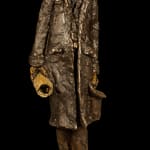

Gib Singleton
Lincoln
Bronze
Available in:
18" Book Edition of 300
33" Edition of 56
57" Edition of 33
90" Edition of 9
18" Book Edition of 300
33" Edition of 56
57" Edition of 33
90" Edition of 9
When you look at this piece, you can see the weight of the world on old Abe's shoulders. The cost of putting a world together - and the loss of...
When you look at this piece, you can see the weight of the world on old Abe's shoulders. The cost of putting a world together - and the loss of life, including his own - is too much for any one person to bear.
And that's what this piece represents. It's him realizing the fact that that has occurred in his life. In order to put a more perfect world together - which is freedom and the end of slavery - he's given everything he has.
And he's standing in this field, with his head down, holding the 13th Amendment in his hand. An old rail splitter from Kentucky and Illinois. That's what he was. And in a way, he did save the world. So did the son of a carpenter save the world. They're two of a kind. There's a lot of similarity between the Crucifixion and Lincoln. You look at this and you look at Christ on the Cross, and it's the same feeling. They can't understand why people crucify each other, like they did in the Civil War. But Lincoln made a country where they had no slavery, and where the word 'freedom' meant something.
He was one of my childhood heroes, and I'm proud to have done this piece. It has all the style and technique I'm noted for, and the feel of Giacometti with the elongation. I think it's a beautiful piece.
-GIB SINGLETON
And that's what this piece represents. It's him realizing the fact that that has occurred in his life. In order to put a more perfect world together - which is freedom and the end of slavery - he's given everything he has.
And he's standing in this field, with his head down, holding the 13th Amendment in his hand. An old rail splitter from Kentucky and Illinois. That's what he was. And in a way, he did save the world. So did the son of a carpenter save the world. They're two of a kind. There's a lot of similarity between the Crucifixion and Lincoln. You look at this and you look at Christ on the Cross, and it's the same feeling. They can't understand why people crucify each other, like they did in the Civil War. But Lincoln made a country where they had no slavery, and where the word 'freedom' meant something.
He was one of my childhood heroes, and I'm proud to have done this piece. It has all the style and technique I'm noted for, and the feel of Giacometti with the elongation. I think it's a beautiful piece.
-GIB SINGLETON

